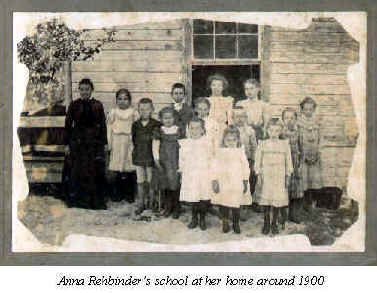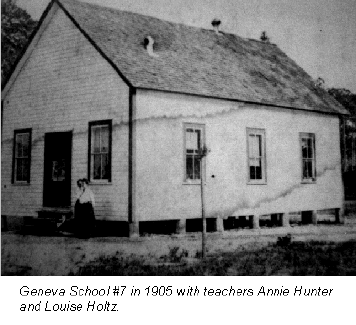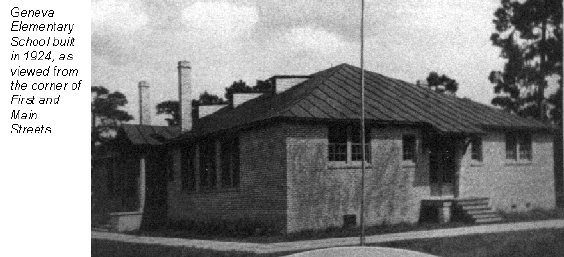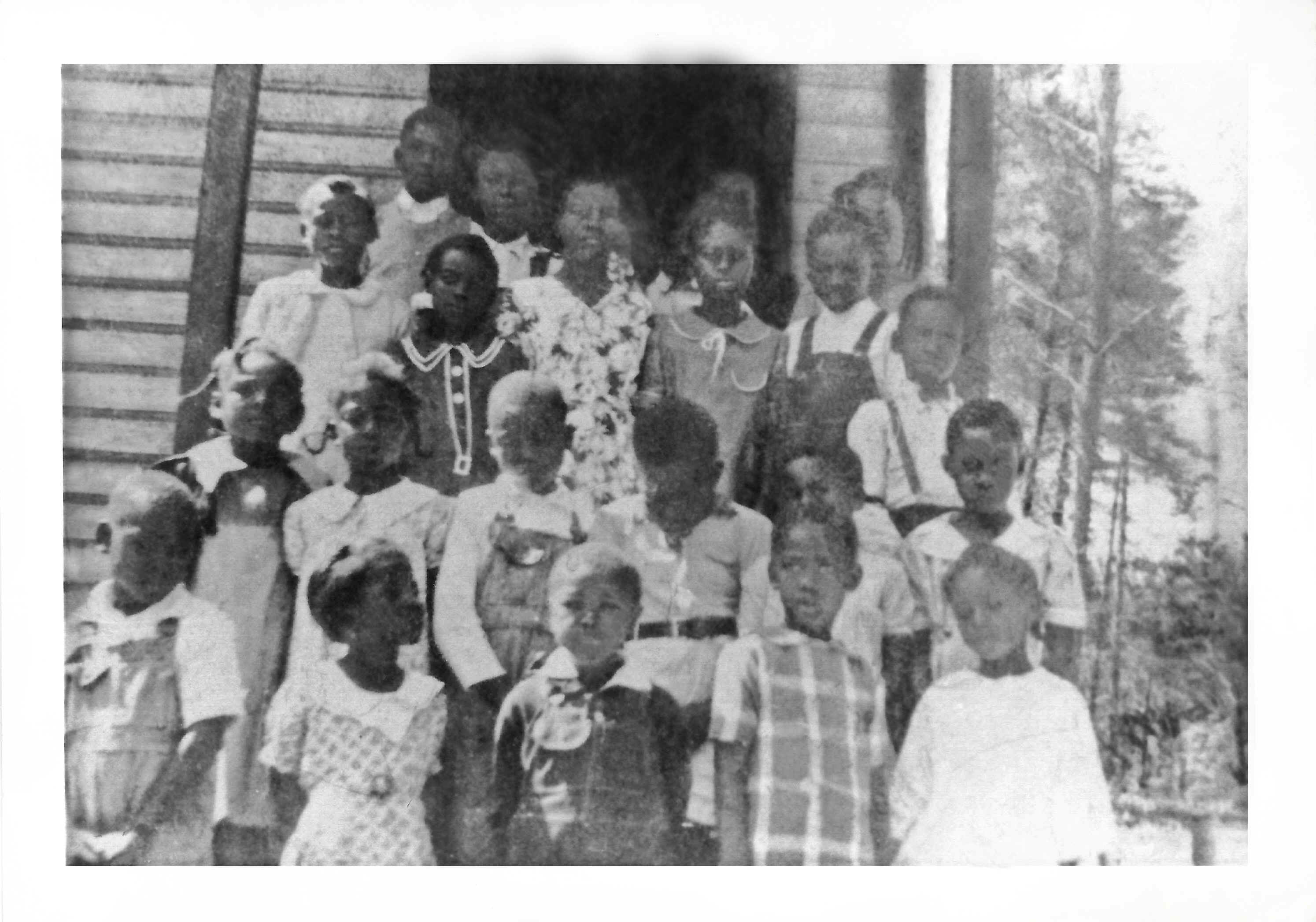
The Geneva Area Schools
(The Act of Congress on 3 March 1845, that admitted Florida and Iowa to the Union, also provided that Section 16 of every township, or other land equivalent, be granted each State for support of public schools. The State Board of Education of Florida was created as a corporation of the State by Section 3, Article 12, of the Florida Constitution in 1845, and was given management of all school lands. This was the foundation of the Public School System in Florida.)
Early Home Schools
In "Geneva Schools in the 1800’s" in the Geneva Historical and Genealogical Society
Yearbook, 1963-64, it is stated:
In the very early years, children went to small private schools in the homes of the teachers. Mrs. W. B. Culpepper taught one such school in her log home in an orange grove just north of Jones’ Corner. She was the grandmother of Carroll Culpepper and great grandmother of Khadra Culpepper Ward. Among the children attending this school were the Williams’ – Sadie, Morgan and Susie, the mother of Clare Harrison Brown and Sue Harrison Torres; Bertha Hart David, mother of Bess Proctor Herman; Malcolm and Billy Prevatt, uncles of T. W. Prevatt; and Phil and Grace Winegourd.
Miss Nellie Rogers taught school at the Nicholson home at Cook’s Ferry where Jasper, Oscar and Nettie (who was the mother of Roy Tillis) were among the pupils. This school was discontinued in 1890, as it was too small. Mr. D. W. Hoyt was the last teacher at Cook’s Ferry.
Miss Rogers later taught at Joe Prevatt’s school on Mullet Lake, where she became ill and died at the home of Mrs. Prevatt, mother of Mrs. Bertha David. She (Miss Rogers) is buried in the Geneva Cemetery. Others who attended the Prevatt School besides the Prevatt children were the Nicholsons, LeFils, and Anna and Ted Russell. An upstairs room in the old red house was used as a classroom. There were others who taught in the Prevatt School on Mullet Lake - Miss Luba DeBogary, whose salary was $22.00 per month; Miss Howe, at a salary of $30.00 per month; Miss Minnie Williams, sister of Mrs. Susie Williams Harrison; Miss Maude Rinaldi; and Miss W. J. Daniel, mother of Dr. Herman Daniel; Mr. Nash and Miss Jeanie Lassiter, sister of Mrs. Helen Alderman.
Mrs. Anna Rehbinder, mother of Leo Rehbinder, still had
a private school in their home in 1886 for which one dollar per month per pupil
was charged. She first taught only the Russian children of Geneva until she
herself could speak English and then taught the various children of Geneva.
Buda School
Also according to "Geneva Schools in the 1800’s", the first school house at Buda was in the house that Mr. Winegourd built and it stood east of the Eugene Smith house on the Chuluota Road. Mr. Winegourd was the brother-in-law of Mrs. Mary Taylor. Instructions at this school were provided from 1873 until 1892 when a new school was built on the southwest corner of the intersection of Snow Hill Road and Old Mims Road. The second school operated from 1892 until 1913 when Buda School was consolidated with Geneva School.
The first recorded teacher in the Buda School found in the Orange County records was Mr. J. H. Owens in 1878 and he received a salary of $30.14. From 1878 through 1885, we have Miss Mary Dart as the teacher and, from the number of old timers who went to school under her, we have assurance that she was there for at least six years. She was a small lady whose back had been broken. One teacher came that would not stay and made a Mr. Hilton take her to the train. She carried a gun to be sure he did not miss the train! Professor Dan Hoyt, stepfather of Miss Dart, was next in 1887. Miss Helen Guinn taught in 1888 and boarded with the Lassiter family. Miss Nettie Wright from Chuluota taught at least 2 terms in 1892-1894.
Miss Wright was the first to teach in the schoolhouse built on the West Side of Chuluota Road, north of the entrance to the Lizzie James place. Other teachers were Miss Sue "Sudy" Morris "in 1895, the pretty one from North Carolina"; Miss Prince, in 1896; Miss Julia Leake, in 1896-1897 and Miss Emma Peters for one term in 1898. Mrs. Garret from Conway taught in 1899. Miss Blanche Wise from Oakland boarded with the Lassiter family and she was a young girl of about seventeen who cried a lot because she was homesick. She was there two terms between 1900-1902. Mrs. A. M. Rehbinder began teaching in 1904 and taught seven years, through 1911. Mr. Leo Rehbinder was the last teacher before Buda School was consolidated with the Geneva School in 1913.
Lake Harney/Geneva School #7
According to the records available in Orange County, there were six public schools in the Buda and Geneva area in the late 1800’s. (Seminole County was formed out of Orange County in 1913.) In the article "Geneva Schools in the 1800’s", one of the six schools was the Lake Harney School #7, a log building on land donated by Progor Debogory near the site of the last home of E. H. Kilbee. Annie Peters Wagnon stated in an interview, "My earliest recollections of Geneva were when my oldest brother went to school at seven years of age (1880). The schoolhouse was near the old Baptist Church and the present cemetery…the cemetery was located just to the east side of the school." Geneva was at that time known as Harney Cove, and Lake Geneva was called Turkey Pond. Mr. Henry Baker, grandfather of Meade Baker, was the first teacher in this school in 1874. A few years later another wood building was built near the northwest corner of the log cabin.
Henry B Jones, born in 1883 in Geneva, said in an interview about life in Geneva:
The schoolhouse was made of planks up horizontally and handmade furniture. There came from that little school, men that I am proud of. Two millionaires, Mr. Raulerson was one and my Uncle Walter Graddick. Two judges, my cousin Judge W. Bert Patishall, and his brother, Will. Also a dentist, and Herman Daniels, the preacher. Henry Jones (myself) became an accountant with Hasken Sells. I feel that the old schoolhouse, way out in the woods, developed some real fine men.
Mrs. Angie Tucker is the first teacher for whom a record was found in Orange County files. She taught in 1877 and her first month’s salary was $32.80, the second month $34.70, and the third month $31.40. The terms seem to have been for as long as there was money to pay the teacher and varied from three to five months. Lake Harney School at this time had been given a special rate of tuition. The first record found of trustees of this school was for the year 1880. The trustees were W. H. Raulerson, I. D. Hart, and W. P. Lassiter, the father of Mrs. Helen Alderman. Old timers recall several that taught either in this school or privately during this period. A Mr. Farrington was remembered for his playing of a trumpet late at night and awakening people. "Uncle Jack" Holder called him "Gabriel."
In an article about the Geneva Schools in the "Geneva Historical Society Yearbook, 1963-64", it is related that, in 1882, Miss T.P. Randolph was the teacher in School #7. In 1888-1889, Mr. Earhart taught and was Mrs. Annie Wagnon’s first teacher. C.A. Saunders taught in 1892. He resigned and was replaced by Miss Ruth Busby. Professor Belton taught in 1893. Miss Bobbie Walker taught in 1894. Mrs. L. H. Emerson was the teacher in 1895. Miss Annie Hunter taught in 1896. William Adkin taught in 1897. He died and was replaced by Miss Lula Graddick. Everett Bray taught in 1898. Miss Lena Short was the teacher in 1899 and Mrs. McQuire was the last to teach in this school building near the cemetery in 1901-1902.
In the book, Russian Immigrants in Geneva, Florida - 1877 , Leo Rehbinder described his early schooling in Geneva:
Once a year we were honored by a visit from a peg-legged, tobacco chewing, Confederate veteran, J. T. Beeks. He was our County School Superintendent and it was his duty to make the rounds yearly and see that the schools were in due operation. The schoolhouse was a frame building about 18 by 24 feet and had long seats seating 5 abreast. The backs of the seats formed desks for the other seats. There was a stove in the center of the room. There were two doors on the West Side of the building. All the girls sat on the north side and went out by the north door and played on the north side of the playground. The boys, likewise, were reserved all the south. We had six months school. When school was out my mother (Anna Rehbinder) would open a six week’s school where I would resume my Russian studies and my Latin, Algebra, and later, Geometry as well as French.
In his later teens, Leo Rehbinder studied to be a teacher under his mother’s tutelage. He relates proudly about the early young teachers of Geneva:
In 1893 W. N. Sheats was elected State Superintendent of Public Schools and was making many innovations, among which was a written examination to be passed by all aspiring to teach. It was commonly predicted that such a course would cause a serious loss of teachers as so many were teaching that could not pass a satisfactory examination. There were eight or ten girls in Geneva and two boys that set out to pass these examinations with my mother’s help. She (Anna Rehbinder) was a wonderful instructor and put them over in fine shape so that none, as I remember, failed. For the next eight or ten years Geneva boasted of having more teachers out teaching than even Orlando or Sanford, thanks to her.
The first young teachers from Geneva were Mary Debogory, Lula Graddick, and Minnie Williams; soon followed by Judson Lassiter, Sadie Williams, Eva Taylor, Luba Debogory, Elsie Proctor, Eva and Rose Gradick, Lola and Addie Gresham, Mattie and Cornie Gilmore, Sina, Ola, and Annie Peters, Mabel Daniels, Mamie McLain, Freeman Pattishall, and Leo Rehbinder.
 By the
1903 term, a new one-room school was built on Main Street just to the east of
the site of the present old brick school building (Family Resource Center).
The
next two terms, 1904-1905, were taught by Miss Annie Hunter and Miss Louise
Holtz after a petition had been put in the building thus forming two classrooms.
Eva Mathieux Markowicz states that the school building was later divided into
three rooms for younger, middle, and upper grades.
By the
1903 term, a new one-room school was built on Main Street just to the east of
the site of the present old brick school building (Family Resource Center).
The
next two terms, 1904-1905, were taught by Miss Annie Hunter and Miss Louise
Holtz after a petition had been put in the building thus forming two classrooms.
Eva Mathieux Markowicz states that the school building was later divided into
three rooms for younger, middle, and upper grades.
According to Elizabeth (Ballard) Beasley in an oral interview, the school was at one time called the Dooley School as Mr. and Mrs. Dooley taught at the school. She attended Dooley School for the first eight years of her schooling before going to Sanford High School.
Marion (Taylor) Allen attended the first grade at the Geneva School in 1919. Her teacher was Miss Elizabeth Stone. She relates that Miss Stone later married Mr. Franklin, the first ticket agent at the Florida East Coast Railroad Depot.
In 1924, a new Geneva School was built out of brick on the corner of First and Main Streets in Geneva. The school had four classrooms originally had twelve grades. By 1933 the school had around 80 students in only eight grades.
At the August 20, 1928 Board meeting, the Board of Trustees authorized an advance to Mrs. G. P. Geiger the sum of $100 to be applied toward the purchase of a school bus for the Geneva students. The sum was to be deducted in installments from her salary. The school buses were obviously privately owned in those days.
 In the "History of the Seminole County Public
Schools", Geneva School is lauded for an accomplishment:
In the "History of the Seminole County Public
Schools", Geneva School is lauded for an accomplishment:
In 1941, under the direction of principal W. L. Sieg, a unique 4-H program was established. Sponsored by Rollins College, the program was designed during the depression to help meet the needs of families. In reality, it was a course on Home Economics and Farming. Female students became adept at canning, sewing, quilting, etc. The boys planted and raised farm animals on the school grounds – chickens, cattle, hogs, even bees. Geneva School won numerous awards with the program. The faculty was invited to speak about the program in Tallahassee. Miami newspapers and the magazine "Progressive Farmer" covered the event. The program had a huge impact on the state curriculum.
The old brick school building served Geneva students well for 64 years. In May 1988 a new Geneva Elementary School was dedicated. The campus surrounds the old brick school building and faces First Street. The old school building was saved for the community and in 1995 was dedicated as a Family Resource Center. The building fell into disrepair and in 2008, the Seminole County School Board agreed to give the historic school building to the citizens of Geneva to become a Rural Heritage Center. A 501(c)(3) organization was formed and after renovation (all by donation), the school has become a Rural Heritage Center celebrating and continuing the Geneva, Chuluota, and Black Hammock rural area traditions.
Kolokee School in Snow Hill

Kolokee was a railroad stop on the Florida
East Coast (FEC) Railway. It was located in what is now the Little Big
Econ State Forest between CR 426 and Snowhill Road. This school for
African-American children was located on Snow Hill Road and was named Kolokee
(the closest named location back then). It was a one-room school on land
donated by Henry Detreville, Sr., on Nov. 6, 1928, according to Orange County
School records. It was first situated just to the south of the
present Snow Hill Missionary Baptist Church but later there was a new larger
school on the north side of the church on land donated by Rev. A.J. Muller.
It however remained a one-room schoolhouse. When the students got older they
attended Crooms Academy in Sanford. Seminole
County school records show that the teacher/principal at the Kolokee School in 1932
was Jennie McPherson; 1933-35 & 1941-46 - Jannie Jackson; 1936-40 - Margaret
Dixon; 1947 - Susie Harrington; and 1948-52 Lillie Robinson Hall. The
Kolokee School closed in 1953 and the students were reassigned to Oviedo
Elementary on Division Street in Oviedo. The school building itself was moved to
relieve crowding at Goldsboro Elementary and the land was deeded to the Busy Bee
Community Club for recreational purposes.
 Geneva School on Cochran
Road
Geneva School on Cochran
Road
The
Geneva School was a one-room school for African-American students in grades 1
through 6 and was located on the west side of Cochran Road, south of what is now
State Road 46. When the students got older they attended Crooms Academy in
Sanford. Seminole County school records show that the teacher/principal at the
Geneva School in 1922 was Fannie Reed; in 1934 - Evelyn Anderson; Marian
Anderson - 1935; Viola Mattox in 1936; and 1938 - 1954 was Ida Muller Anderson.
As a
student Eula Banks Witherspoon remembers, “Sometimes we’d get together, and
the children would come from Kolokee, and we would all walk down to Osceola
School. Ms. Anderson would take the smaller children and we’d catch the
train back.” The Geneva School on Cochran closed in 1954 and the
students were reassigned to Oviedo Elementary on Division Street in Oviedo.
Osceola Schools
There were two schools at Osceola for the children of the Osceola Cypress Mill workers - one for white students and one for African-American students. The schools were opened around 1916 when the mill town was built and remained open until 1939 when the mill was moved to Port Everglades. Mrs. Dooley and Mrs. Moran were two of the remembered teachers at the white school.
Compiled by M & M Martin
Resources
Geneva History page.Allen, Marion and Markowicz, Eva. "Oral History of Geneva - #3." 1999.
Banks, Eddie; Stewart, Altamease; Witherspoon, Eula. "Oral History of Geneva - #1." 1998.
Beasley, Elizabeth Ballard. "Oral History of Geneva - #2." 1998.
Geneva Historical Committee. "Geneva Schools in the 1800’s." Geneva Historical and Genealogical Society Yearbook. 1963-64.
Jones, Henry B. An oral interview. Prior to 1976.
Mathieux, Joseph. "The Geneva and Buda Schools." 1997.
Rehbinder, Leo Michael. "Geneva in the Nineties."
Rehbinder, Leo Michael. Russian Immigrants in Geneva, Florida - 1877 -
(An Autobiography by Leo Michael Rehbinder). Geneva Historical & Genealogical Society, Inc. Geneva, FL. 2001.South Florida Sentinel. "Community Affairs, East Orange." July 20, 1894.
Unknown. "Report on 1930’s Geneva School and Community Program."
Wagnon, Annie Peters. A recording for the Geneva Historical Society.
Wawrzaszek, Le Anne, researcher. "History of the Seminole County Public Schools: 1825-1985."
"Written and Pictorial History of the Oviedo Area Colored Schools - 1890-1967". 2001. Judith Smith Publishing.
Return to